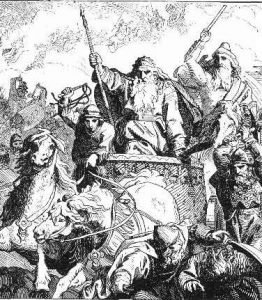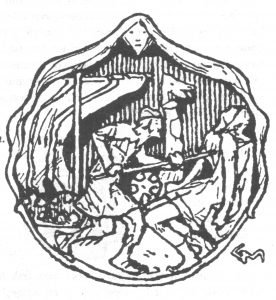A list of Kings of Hedeby also known as Haithabu, they ruled over the Danish lands with Hedeby as their economic centre. The early King lists of Hedeby have a lot of duplicate entries, which contradict each other and do not match with the contemporary historical records. It was a turbulent time with various families competing for the throne with at least two civil wars, one in 812-814 and another in 854. These were the legendary Kings of the Danes who ruled over Denmark and much of Norway in the late 8th Century and early 9th century. There was another Royal line who ruled over Sweden that were eventually defeated by the Loðbrók dynasty in 860.
- Harald Wartooth (Died in 772).
- Sigurd “Hring” Ranversson (Died in 798).
- Harald Redbeard (Died in the Irish Sea in 804).
- Gudrød “The Magnificent” (Murdered in 810).
- Hemming (Killed in 812 by the sons of Gudrød).
- Harald Klak with his brothers (Exiled in 814).
- The sons of Gudrød (A brief rule from 814-820).
- Harald Klak ( Returned in 820 until he was again exiled in 826).
- Hrørik Gudrødsson (Ruled from 827 until his violent death in 854).
- Ragnar Loðbrók (Murdered in abt 864 by King Aella of Northumbria).
- Sigurd “Snake in the Eye” (Ruled jointly with his brothers from 867).
- A period of instability while the Loðbrók dynasty focused on the British isles.
- Bacgsecg a puppet king of the Loðbrók dynasty died in 871 during with the heathen army under the leadership of Halfdan.
- Harald “Fine Hair” (In 871 he took advantage of the instability in Denmark and for a couple of years ruled both Norway and Denmark).
- The Loðbrók dynasty (Returned to Denmark in 873 and started a very long conflict with King Harald that lasted generations).
- Another period of instability when Sigurd “Snake in the Eye” drunk with power left Denmark to rule Viking Scotland creating instability once again in Denmark.
- Olaf the Brash of Sweden (Conquered Denmark in Sigurd’s absence and founded the House of Olaf).
- Gyrd and Gnupa.
- Sigtrygg Gnupasson.
- Cnut I son of Sigurd successfully defeated the House of Olaf and became the first King of all Denmark.




You must be logged in to post a comment.